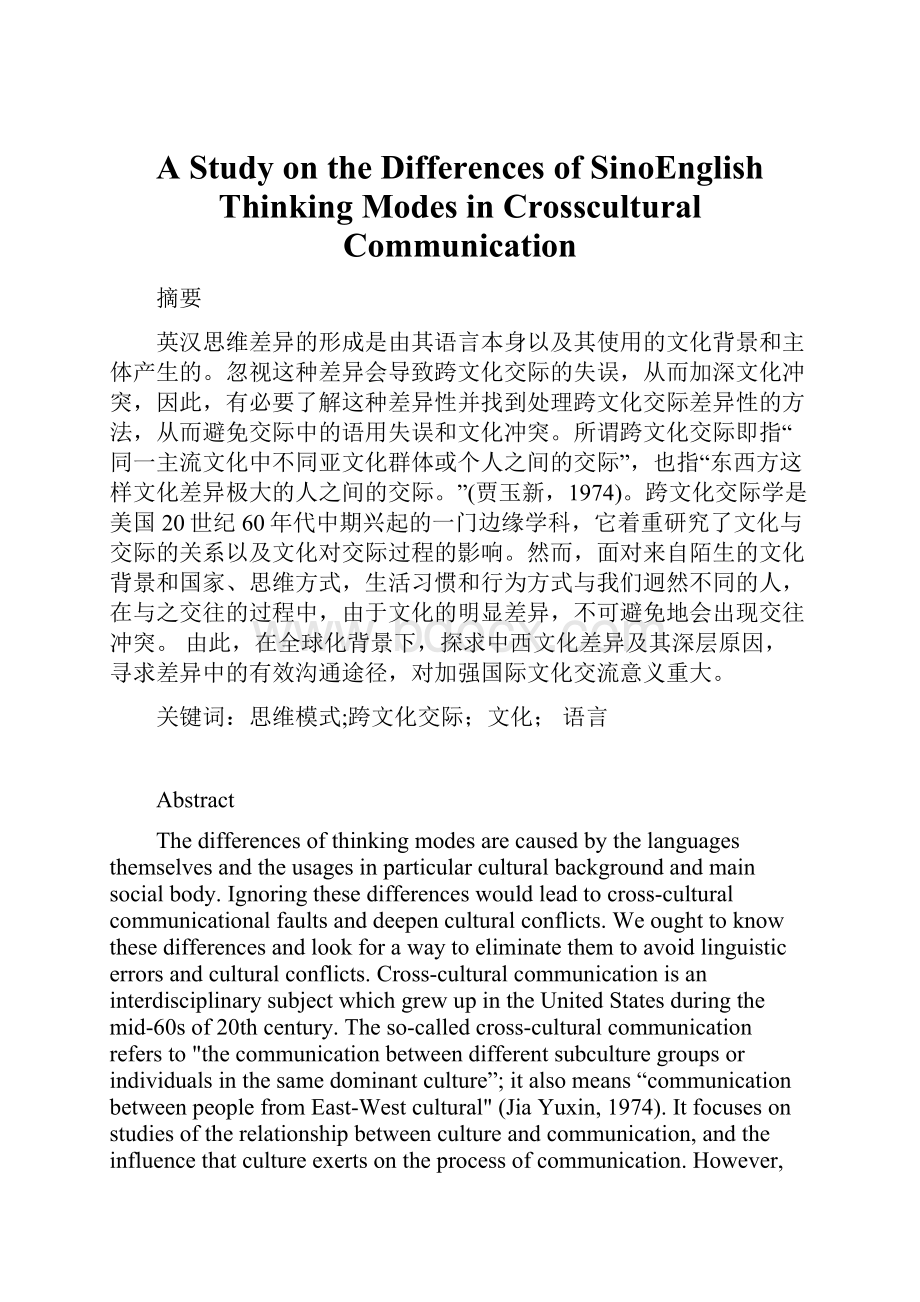A Study on the Differences of SinoEnglish Thinking Modes in Crosscultural Communication.docx
《A Study on the Differences of SinoEnglish Thinking Modes in Crosscultural Communication.docx》由会员分享,可在线阅读,更多相关《A Study on the Differences of SinoEnglish Thinking Modes in Crosscultural Communication.docx(19页珍藏版)》请在冰豆网上搜索。

AStudyontheDifferencesofSinoEnglishThinkingModesinCrossculturalCommunication
摘要
英汉思维差异的形成是由其语言本身以及其使用的文化背景和主体产生的。
忽视这种差异会导致跨文化交际的失误,从而加深文化冲突,因此,有必要了解这种差异性并找到处理跨文化交际差异性的方法,从而避免交际中的语用失误和文化冲突。
所谓跨文化交际即指“同一主流文化中不同亚文化群体或个人之间的交际”,也指“东西方这样文化差异极大的人之间的交际。
”(贾玉新,1974)。
跨文化交际学是美国20世纪60年代中期兴起的一门边缘学科,它着重研究了文化与交际的关系以及文化对交际过程的影响。
然而,面对来自陌生的文化背景和国家、思维方式,生活习惯和行为方式与我们迥然不同的人,在与之交往的过程中,由于文化的明显差异,不可避免地会出现交往冲突。
由此,在全球化背景下,探求中西文化差异及其深层原因,寻求差异中的有效沟通途径,对加强国际文化交流意义重大。
关键词:
思维模式;跨文化交际;文化;语言
Abstract
Thedifferencesofthinkingmodesarecausedbythelanguagesthemselvesandtheusagesinparticularculturalbackgroundandmainsocialbody.Ignoringthesedifferenceswouldleadtocross-culturalcommunicationalfaultsanddeepenculturalconflicts.Weoughttoknowthesedifferencesandlookforawaytoeliminatethemtoavoidlinguisticerrorsandculturalconflicts.Cross-culturalcommunicationisaninterdisciplinarysubjectwhichgrewupintheUnitedStatesduringthemid-60sof20thcentury.Theso-calledcross-culturalcommunicationrefersto"thecommunicationbetweendifferentsubculturegroupsorindividualsinthesamedominantculture”;italsomeans“communicationbetweenpeoplefromEast-Westcultural"(JiaYuxin,1974).Itfocusesonstudiesoftherelationshipbetweencultureandcommunication,andtheinfluencethatcultureexertsontheprocessofcommunication.However,whenfacingthosewhohaveanunfamiliarculturalbackgroundorcomefromdifferentcountries,whosemodesofthinking,livinghabitsandbehaviorpatternsarecompletelydifferentfromus.Conflictsareinevitableduringcommunicationduetotheobviousculturaldifferences.Forthisreason,inthecontextofglobalization,itissignificanttoexploreculturaldifferencesstrengthentheinternationalculturalexchanges,underlycausesforthedifferences,andlookforaneffectivemethodofcommunicationindiversity.
Keywords:
modesofthinking;cross-culture;communication;culture;language
TableofContents
Outline1
Introduction3
Chapter
ThinkingModes4
1.1.DeterminantofThinkingModes4
1.2.ReasonsoftheDifferences4
1.3.ThinkingModesandCross-culturalCommunication5
1.3.1.PragmaticFailure5
1.3.2.CulturalCollision6
Chapter
AspectsoftheDifferences7
2.1DailyCommunication7
2.1.1AddressTerms7
2.1.2Greetings8
2.2TabooWords9
2.3AMatterofFace10
2.3.1ChineseViewofFace11
2.3.2Westerners’ViewofFace12
2.4InternationalCorporateEvents13
2.4.1ViewofTime13
2.4.2ViewofSpace15
ChapterⅢMethodstoEliminateDifferences17
4.1.ForeignLanguageTeachingandLearningSystem17
4.2.TheLearningLaw18
4.3.CulturalCultivation18
4.4.WesternCulturalMaterials19
4.5.NonverbalCommunicationAbility20
Conclusion22
Bibliography23
Acknowledgements25
Outline
Thesisstatement:
Thinkingmodesaffectthecross-culturalcommunicationastheyareproducedbythelivingenvironmentsandculturalbackgroundsofthelanguagespeakers.
.Introduction
.Whatisthinkingmode?
A.Whatdeterminemodesofthinking?
B.Whythinkingmodesaredifferent?
C.Thereareconnectionbetweenthinkingmodesandcross-culturalcommunication.
.Someaspectsofthedifferencesofthinkingmodesthatarecommon.
A.Thinkingmodesinfluencesocialcontact..
1.Addresstermshaveanimportantsocialfunction.
2.DifferentgreetingsareusedinChinaandEnglishspeakingcountries.
B.TherearemanytaboosinbothChineseandwesternculture.
C.FacetheoriesexistinChinaandEnglish-speakingcountries.
1.ViewoffaceinChina.
2.ViewoffaceinWesterncountries.
D.Factorsaffectinternationalcorporateevents.
1.DifferentviewsoftimeexistinChinaandEnglish-speakingcountries.
2.DifferentviewsofspaceexistinChinaandEnglish-speakingcountries.
.Itismeaningfultounderstandthethinkingmodes.
A.Itunveilsthedifferencesofthoughtsupplement.
B.Itenhancesculturalcommunicationbyunderstandingthelearninglaw.
C.Knowingtheculturalcultivationishelpful
D.MakingfulluseofWesternculturalmaterials.
E.Thenonverbalcommunicationabilityisalsoimportant.
.Conclusion:
Thinkingmodescaneasilyaffectourcommunicationwithforeignersintheaspectsofsocialcontact,taboos,facetheories,anddifferentviewsoftimeandspaceinChinaandEnglish-speakingcountries.Weshouldusesomeeffectivewaystodecreasethosedifferences.Itisdifficulttoeliminatethosefaultsuntilwerealizethem.Timeisneededtoadapttothosedifferences,analyzethereasons,andsolvethem.Languageisthebasicmethodininternationalcommunication,whatweshoulddowhenlearningforeignlanguagesistostudythenativespeakers’thinkingmodesandculturetomaketheworldtrulyclose.
Introduction
Thinkingisabstract,untouchableandinvisible,andinternationalthroughsomeforms.Andlanguageisanimportantcarrierofthoughtwhichiscalledthinkingmode.Theydifferbecauseoftheculturalbackgroundsanddisplaysomeculturalconflicts,suchastheaddresstermsindailylife,greetingwords,taboowords,faceproblemsetc.Itisalsoshownininternationalcorporationsasdifferentpeoplefromdifferentcultureshavedifferentviewsintimeandspace.Forexample,EnglishbelongstotheWesternlanguagesystem,whichhasadistinctivefeatureofanalysiswithintheusers;ChinesebelongstoEasternlanguagesystem,whichhasthegreatestcharacteristicofholismandstronglogicality.Theusersholddifferentworldviews,valuesviewsandculturalbackgrounds,andtheirmethodsandveracityofexpressionwillbedifferent.Whendealingwiththeseproblems,peoplearenotrequiredtochangetheirexistingmodesofthinking,valueviews,worldviews,butthroughthemasteryofthelanguagesavoidnegativetransferwhichconstructanothersetofthinkingmode.Inthispaper,theauthoralsogivessomeeffectivemethodstosolvethoseconflicts.Bothlearningsystemandteachingsystemshouldbeimproved.Wealsoshowourattentiontononverbalcommunicationabilitywhichwouldinfluenceourhabits.
Chapter
.ThinkingModes
Thoughtisthethingthathumanbrainreflectscognitiveactivityoutsideofthings.Aparticularmodeofthinkinghassomesocialfeatures,suchas,stability,structure,stylizedinaparticularfiled.Therefore,theso-calledmodesofthinkingistheuniversalandstablestructureandprogramofthinkingwithinthecognitiveprocessofhumanbeings,whichisthelawandmeansofthinkingcombinedbyaunifiedway.Differenceofthinkingmodeisoneimportantreasonthatresultsinculturaldifference.Understandingculturaldifferencesandmodesofthinkingcanhelpustocrosstheresultingbarriers,andeffectivelycommunicateandcooperateintheinternationalculturalenvironments.
1.1.DeterminantofThinkingModes
Culturalmodeldeterminesthemodesofthinking.Eachnationlivesinaspecificnaturalandgeographicalenvironmentandhasformeditsownhistoricalbackground,culturaltraditions,anditsownthinkingmodes,whichresultsintheculturaldifferences.Modesofthinkingvarywithdifferentculturalbackgrounds.Peopleareusedtothinkingproblemsintheirownculturalunderstanding.Forexample,whenwewritetheaddress,theordermustbe:
thecountryname-provincename-townnames-streetnames-residentialhousenumber–recipient,buttheAmericansdoitjustthereverse.Thisshowsdifferencesbetweentwothinkingmodes.
1.2.ReasonsoftheDifferences
Peopleofdifferentcultureshavedifferentcognitivemodelstotheoutsideworld,andthethinkingmodesmustbedifferent,too,especiallybetweenEastandWestcultures.Westerncultureischaracterizedbylogicalthinkingandanalysiswhiletheorientalisintuitivelyholisticthinking,atypicalChineseculture.Livinginthisculture,Chinesepeopleattachgreatimportancetothingswithintuitivefeeling,whichresultincognition,perceptionandexperience.Andfollowingthisexperienceandfeeling,Chinesepeopleoften“measureanotherman'sfootbyone'sownlast."Suchmodeofthinking,whichconstitutestheircoreofknowledgeandcommunication,hasanobviousgeneralityandvagueness.Thisthinkingmode,intime,developsamentalsetwhichcanbeinterpretedastheprocessofperceptionandidentificationofthingsoutside.Inessence,thementalsetistoogeneralized.Weusuallyignoretheindividualdifferencesandexaggeratethecognitiveadditionofasocialgroup.Frequentlythissetisemotionallyaccompaniedbyafixedcreed.Itwillaffectthecross-culturalcommunicationdirectlyandresultincommunicationfailurebecauseourpredictionofthebehaviorisbasedonafixedviewoftheirculture.
1.3.ThinkingModesandCross-culturalCommunication
SincetheexistenceofdifferencesbetweenChineseandWesternthinkingmodes,barriersincross-culturalcommunicationoftenoccur.Thisinvolvesnotonlyspelling,grammar,vocabularyandsoonbutalsopragmaticfailureandculturalcollision.
1.3.1.Pragmaticfailure
Pragmaticfailuredoesnotmeanthemisapplicationthatappearsinthegeneralwordingofsentences,butmalaproposmistakeofspeaking,orwrongwayofexpressionandunidiomaticexpressions.Theerrorswillmakecommunicationcannotachievetheexpectantresults.Thomas(1983)dividedcross-culturalcommunicationfailuresintopragmaticfailureandsocialusagefailure.Pragmaticlanguageexpressionincludesidiomsmistakes,errorsintheformsofaddress,greetingblunders;socialpragmaticfailureincludesdifferencesincustoms,differencesofsenseofworthandmistakeswhichresultfromuniqueculturalfactors.
1.3.2.Culturalcollision
Culturalcollisionspeciallyreferstopeoplefromacultureinteractwithotherpeople